![]()
The following guidelines are designed to increase everyone's enjoyment of our sport, maintain good relations with the community, promote foxhunting traditions, and maximize the safety of all participants.
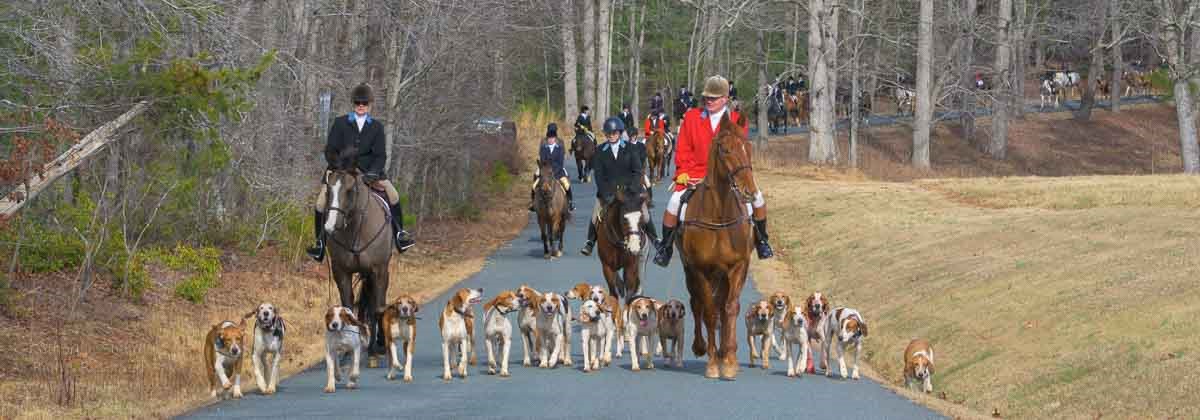

The sport of foxhunting requires suitable land in large quantities. Such land is not easy to find and can be lost to hunting by acts of carelessness or ignorance. Our first set of guidelines advocates courteous and responsible behavior to landowners. Hunt country is private property. Riding on non-hunt days must be done with prior permission of the landowner. Do not assume you can freely trail ride on land that we hunt.
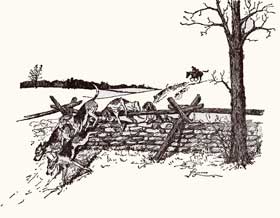 Gates: Leave gates as they are found. Riders are responsible to pass the word to followers either “gate closed” or “gate open” before continuing. When in doubt, the last rider should close the gate and report the action to the Field Master or a staff member.
Gates: Leave gates as they are found. Riders are responsible to pass the word to followers either “gate closed” or “gate open” before continuing. When in doubt, the last rider should close the gate and report the action to the Field Master or a staff member.
Cultivated Ground: Do not ride over plowed or planted ground. This includes hay fields. If the landowner has provided bridle paths on the edges of his fields, ride only on these paths. Most farmers now use the no-till method of farming. This means that they don’t plow their fields in the spring but plant their seeds with no obvious preparation of the ground. Hoof prints in the soil interfere with the proper functioning of the special planting machine and thus reduce the harvest. To lessen the damage horses do to cultivated fields, we must ride at all times on the extreme outer edge and in single file. In areas that are not cultivated but allowed to grow in heavy turf, riders should spread out and not ride in file so as not to make paths. This also gives the Field a better view of the hounds. The Field Master will signal when the Field should spread out.
Livestock: Ride slowly and try to avoid livestock. If any of them break through a fence or go through a gate opened by the Hunt, report it to the Field Master.
Equipment on Location: Ask permission before using any equipment such as hoses and water faucets to wash horses. Avoid creating a muddy area.
Trash: Clean up trash and manure. Trailers should not be mucked out at the meet. Clean up the area around trailer parking spaces.
Appreciation: If the landowner or his/her representative is present, you may express your individual thanks and appreciation.
Trailers: Always check your hitch. Park so that you allow enough space to unload and tie horses safely. Be aware of parking conditions and always check the hunt line or fixture card for specific parking instructions.
Babbler: A hound that gives tongue (speaks) simply from excitement, without regard for the line (scent).
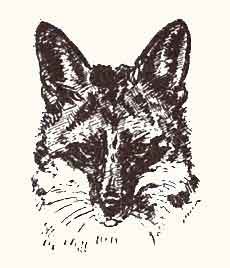
Biddable: A hound that obeys well and is responsive to the huntsman. He can be lifted off one line brought to a new line and will hunt that line. He only hunts fox, not any other game.
Break Covert: A fox breaks covert (cover) when he runs out of it.
Breast High: Scent is said to be breast high when it rises to the level of the hounds’ noses so they can hunt at top speed.
Brush: The fox’s tail.
Capping Fee: The amount paid by visitors (prior to the hunt) for the privilege of a day’s hunting. (In the early days visitors paid the fee in silver and dropped it in the cap of the Hunt secretary.)
Check: When the field stops. Also known as a hold.
Colors: A collar of definite color registered for a particular Hunt.
Country: The area assigned to a Hunt.
Couple: Foxhounds are coupled together (attached by leather collars) by twos. Foxhounds are always counted by twos known as a couple.
Covert: (Pronounced “cover”.) An area, usually wooded, which provides protection for animals.
Cry: The voice of a foxhound pursuing quarry is called a cry, or, giving tongue. Full cry occurs when every hound in the pack cries on the line of a fox.
Cub Hunting:The weeks preceding the beginning of formal foxhunting are known as the cub hunting season. It is technically incorrect to refer to this as Cubbing Season, although the expression is widely used.
Cub: A young fox.
Cur Dog: Any dog, other than a foxhound, is known as a cur dog by foxhunters.
Draw: The Huntsman and hounds are said to “draw a covert” when they search every part of the covert for a fox.
Field: Those who follow foxhounds on horseback, other than the Hunt staff, are known as the Field. They are usually led by a Field Master. The fields are often split into First Flight, Second Flight and Third Flight depending on the size of the group. First flight attempts to keep up with the huntsman and jumps obstacles as necessary. Second flight attempts to keep up with the huntsman but usually goes through gates rather than jumping obstacles. Third flight moves at a slower pace with the goal of maintaining a view of the huntsman and field, often known as "hilltopping".
Fixture Card: Lists the dates, times, and places where hounds and riders will meet during the ensuing month.
Foil: When a fox doubles back on his line, he is said to “run his foil.” Ground is foiled when it bears some scent (sheep, cattle, etc.) besides that of a fox.
Go To Ground: A fox “goes to ground” when it takes refuge in a hole.
Gone Away: The call “gone away” indicates the fox has left the covert.
Guests: Guests are encouraged, but they must have permission from a Master, be properly attired and be accompanied by a member of the Hunt.
Hark: A command used by the Huntsman to encourage hounds to listen.
Hit the Line: A hound hits the line when he finds the line (scent) and gives tongue.
Hold Hard: Stop, please!
Holloa: Pronounced “Holler.” The high-pitched call of someone such as the first Whipper-in who views (sees) a fox breaking covert.
Huntsman: The Huntsman is in charge of and directs the hounds on hunting days. When the Master or an amateur hunts hounds, he or she is known as the Honorary Huntsman.
Lark: To “lark” is to jump fences when hounds are not hunting or when on the way home after hunting. The Farmington Hunt does not recommend larking.
Make Way: If the Huntsman wants to warn the Field of the approach of hounds, he or she will say “hounds please,” “Huntsman please,” or “make way.”
Mask: The head of a fox.
Meet: The place where hounds, horse, staff, and Field gather to begin hunting.
Over Ride: To ride too close to the hounds.
Pocket: A member of the Field is guilty of riding “in the Huntsman’s pocket” when he continually gets so close as to interfere with hunting the hounds.
Ratcatcher: A term used to designate the informal clothes worn during the cub hunting season.
Rate: To rate a hound is to scold him.
Reverse Field: When the field needs to go in the opposite direction. Riders should pull off the trail, turn their horse's head to face the trail, and let the Field Master pass. A similar protocol may be required when making way for staff or a different field: riders pull off the trail, facing their horses heads in the direction of the trail and then moving off again in order when indicated by the Field Master.
Riot: When hounds hunt forbidden quarry (example: a deer).
Scat: Fox manure.
Scent: The odor emitted from glands of animals that is left on the ground, thus leaving a trail (line) which can be followed, i.e., fox by foxhounds.
Staff: The Hunt staff consists of the Master or Joint Masters, the Huntsman, the Whippers-In, and the Field Master.
Tally Ho: A call indicating the fox has been viewed.
Tongue: A hound is said to give tongue or to throw its tongue when it draws the first covert.
View: A fox is “viewed,” rather than “seen.”‘
Ware: This means beware of holes or wire, etc.
Whippers-In: The Huntsman’s assistants. If the Whipper-In is an amateur, he or she is called an Honorary Whipper-In.
The Master/Joint Masters: The Masters of Foxhounds have final authority in all matters of hunting. The Masters are responsible for the kennels and keep in close touch with the Huntsman on all matters relating to the hounds. The traditional greeting for a Master is “good morning,” whatever the time of day.
 The Huntsman: Hounds are walked, trained and hunted by the Huntsman.
The Huntsman: Hounds are walked, trained and hunted by the Huntsman.
The Whippers-in: The Whippers-in are the Huntsman’s assistants on hunting and hound-walking days. They help control the hounds by moving hounds back to the Huntsman should the hounds stray and monitor game movement for the Huntsman. Whippers-in are known as honorary when they are volunteers.
The Field Master(s): The Field Master(s) are appointed by the Master(s) to lead the Field. Each Field Master is responsible for showing sport to his/her Flight and is the liaison between the Huntsman and the Field. He/she also has to make sure that the Field does not interfere with the hounds. There are currently three Field Masters.
Although hounds and staff provide the sport of Foxhunting, it is the Fieldmaster who enables those who follow to enjoy it.
Alexander Mackay-Smith
The First Flight moves directly behind the Huntsman at varying rates of speed, over and through all obstacles.
The Second Flight follows behind the First Flight but moves at a steadier pace, and jumping is not required.
The Third Flight (Hilltoppers) proceeds at a much more modest pace to “view” the activities of the hounds, Huntsman and First and Second Flights.
Tack: All tack must be plain, serviceable and clean. Use bitting suitable to control your horse; under the exciting conditions of hunting, control is essential. Saddle pads should be white. String girths are acceptable, but they must be clean. Avoid colored browbands. Rubber reins are acceptable, but they must be brown. A copy of a valid negative Coggins and Hunting License must be brought to each meet.
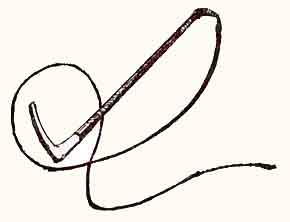
Horse: Foxhunting is a demanding endeavor. Be sure your horse is fit and able to handle the excitement of the hunt. Farmington offers summer "walk and talk" trail rides that will introduce riders and horses to riding in lare groups at a controlled pace. Experienced hunt riders are available to help train you and your horse to handle all conditions of the hunt: riders should be able to keep their horses a minimum of one horse length distance from the horse ahead; horses should be able to stand quietly in a group if there is a "hold" or "check" and to move quickly out of the way and not get nervous if there is a "reverse field", horses should be used to hounds and not kick if a hound gets underfoot.
Horses should be clean and have their manes pulled. If your horse might kick, put a red ribbon in its tail and ride at the end of your field. If your horse is new to the sport, put a green ribbon in its tail and ride at the end of your Field. Try riding in third flight prior to moving up to second and then first flight. Those in first flight should be able to jump obstacles while maintaining a safe distance between horses. Most fences in the FHC territory are 3' or under.
Foxhunting is rigidly conventional. It is a ceremony enjoyed by participants and spectators. Attention is given to attire out of respect for tradition, safety, comfort, and practicability. Riders must also bring a valid negative Coggins and carry their hunting license. The following is a summary of the attire for to the Farmington Hunt:
The term "ratcatcher" applies to the least formal attire permitted in the Field, to be worn during cub hunting season (from Labor Day to Opening Meet) and on informal days during the regular hunting season (Thursday meets prior to January 1st; Tuesday and Thursday meets after January 1st). Ratcatcher attire may be worn on formal days by Juniors.
Coat: A tweed or wool coat in muted colors (no red), tailored and vented, is appropriate. In warm weather, at the discretion of the Masters, coats may be waived.
Vest: A canary or tattersall vest is optional.
Shirt: During Cub Hunting season, solid polo shirts or turtleneck (other than red), tucked in, are permissible if coats are excused. With a coat, acceptable attire includes a riding shirt with choker (for ladies), necktie (both) or stock (both). FHC also allows turtlenecks with no additional neckwear, although this is not necessarily acceptable at other hunts so should be avoided when visiting other hunts.
Stock: A stock tie in a conservative plaid or coordinating color may be worn with a ratcatcher shirt and vest or coat. Below is a diagram demonstrating how to tie a stock tie.
Headgear: A black or brown hunting cap is required, and the Masters of Farmington strongly recommend a hunting cap with harness. Juniors must wear a hunting cap with harness.
Breeches: Any earth tone color of breeches or jodhpurs are allowed but tan and rust are preferred.
Boots: Boots must be clean and polished. They can be either brown or black leather, and may be dress (without laces) or field (with laces). Half chaps are acceptable if they resemble tall boots and are worn with polished paddock boots of the same color. Rubber boots are acceptable, as are canvas-topped (Newmarket) boots. Jodhpur boots worn with Jodhpur pants may be worn by Juniors.
Hunt Whip: A regulation hunting whip is optional for those with colors. Thong and lash may be removed during cub hunting. A short plain-colored riding crop is also optional.
Belt, Spurs, Gloves, Raincoat, Stock Pin, Hairnet, Wire Cutters: Same as for Formal Hunting.
Opening Hunt (near the end of October) is when formal dress is required for all Saturday and Tuesday meets (prior to January 1) and all Saturday meets (after January 1).
Coat: Gentlemen without colors should wear a plain black hunting coat or frock coat. Ladies without colors should wear a plain hunting coat or frock coat, preferably in black or navy. The coats must have three plain black (or matching) front buttons. Frock coats (which have a seam at the waist) have two additional buttons on the back. Ladies (but not gentlemen) awarded colors may add Belgian Blue to coat collars, and buttons can be changed to black engraved FHC buttons. Gentlemen awarded colors and gentleman Masters may wear scarlet (frock) coats with Hunt collar and brass buttons. It is not appropriate to wear colors while visiting another Hunt without prior approval from that Hunt’s MFH. You should keep your coat buttoned at all times.
Vest: Vests are optional and should be canary, tattersall or “Belgian Blue” for members with their colors.
Stock: A white stock tie is required for formal hunting. See diagram above for tying instructions or have an experienced Hunt member tie it for you.
Headgear: A hunting cap is required, either black or navy (for ladies) A Bowler or Top Hat should only be worn with the corresponding hunt attire. The Masters of the Farmington Hunt strongly recommend a hunting cap with harness. Juniors must wear a hunting cap with harness.
Breeches: Gentlemen without colors wear tan and lady members wear buff, tan or canary breeches. Gentlemen with colors may wear white breeches.
Belt: A belt is recommended, as it can be used as equipment in an emergency, i.e., a broken stirrup or as a sling.
Boots: Boots must be clean and polished. Plain black boots with or without black patent leather tops (sewn on) should be worn with black hunting coats. Gentlemen with colors wearing frock coats (black or scarlet) should add russet leather tops to their boots (sewn on). In wet weather, one may wear French rubber boots which look like leather boots (although this may not be allowable if visiting another hunt).
Spurs: Spurs are optional. They must be heavy and blunt, without rowels or chains and set high on the boot below the ankle and with spur arms parallel to the ground. The straps must be the same color as the boots.
Gloves: Gloves are optional. For dry weather, these should be brown, tan or black leather. In wet weather, white wool or cotton string gloves are allowed.
Raincoat: Raincoats should be used sparingly and be of muted colors (brown, black or dark green). Look to your Master(s) for guidance. When visiting another Hunt, ask your host what is proper.
Stock Pin: Plain gold stock pins are proper for both sexes. These should be attached horizontally to the stock tie. Stock pins with the Farmington Hunt logo are optional for those who have been awarded colors. FHC also allows ornamental stock pins, but this may not be acceptable at other hunts.
Hunt Whip: A regulation hunting whip is optional for those with colors. A short plain colored riding crop is also optional.
Hair Net: Hair should be neatly confined with a hair net for ladies. Long hair should first be tucked under the helmet or in a bun.
Flask and Sandwich Case: A pocket flask is optional. Gentlemen may carry a flask or sandwich case (or both) attached to the saddle, and lady members may carry either a sandwich case or a combination flask and sandwich case attached to the saddle. (Be prepared to share!)
Wire Cutters: Only Staff are authorized to use wire cutters during a hunt.
The privilege of wearing the colors and buttons of the Hunt is awarded at the discretion of the Masters. Those awarded colors exhibit knowledge of the sport, its protocol and Hunt territory. Members with colors have the privilege of riding in the front of the field. Farmington colors are awarded at the Thanksgiving meet.
![]()
Punctuality: Arrive at the meet correctly attired, tacked, mounted, and ready to ride. Hounds “move-off” at the appointed time. If you are late, do not expect the Hunt to wait.
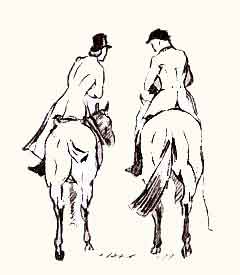 Announcements: At the beginning of the meet, the Master will call the riders to attention. Please collect quickly and quietly. This is an important time for announcements about the Hunt activities and conditions. When announcements are made, cease conversation and listen. These may concern safety or success in the conduct of the Hunt.
Announcements: At the beginning of the meet, the Master will call the riders to attention. Please collect quickly and quietly. This is an important time for announcements about the Hunt activities and conditions. When announcements are made, cease conversation and listen. These may concern safety or success in the conduct of the Hunt.
Hounds: Hounds have the right of way. At the meet, the field is obliged to stay at least 50 feet from the hounds. Keep away from the hounds and turn your horse’s head (never heels) toward the pack. Ride wide of hounds and not behind or alongside. If riding before hounds, turn out of track and let them pass. If you see a hound coming behind your flight pass the words, “ware hound” so all riders in front of you watch out for the hounds to pass safely. If your horse kicks a hound, tell the Field Master and take your horse home.
Making Way: As the hounds work, Whippers-in will be busy. When you hear, “Staff please”, it means a staff member is trying to get by or the Field is about to reverse. Turn your horse’s head toward the staff person and back out of the way. Nothing is more frightening or difficult for a staff person than to face the rear of twenty unknown horses.
Moving Off: When the Field Master gives the signal to move off, it is important to follow him or her immediately as it is disruptive to have gaps in the field.
Riding Order: Intermediate and Junior members are to ride behind senior members. Older members and those with their colors should be given priority.
Safe Interval: Maintain a safe interval between your horse and other riders.
Field: Always obey the Field Master and never get ahead of the Field Master. If the Field Master does not jump a fence, you should not jump the fence. He or she alone is able to judge the safety of a fence.
At the Jumps: Be especially careful about spacing at jumps. You need to give yourself room to stop in case there is a problem or a hound is in front of you. If your horse refuses a jump, it is preferable to take him to the back of the jumpers. However, as Farmington country has a lot of tight places, it is not always possible to safely take your horse to the back. If there isn’t room, go carefully around the jump and catch up.
Keep Talk To Minimum: This applies to everyone. One of the pleasures of foxhunting is listening for a hound when he first gets the slight scent of a fox and calls the other hounds to him to verify his find. If anyone in the Field is talking, it not only makes it difficult to hear the music, but it distracts the hounds. Most people enjoy other sounds of the woods and fields such as the song of the birds and the cry of the crows as we invade their territory. Excessive and loud talking interferes with these pleasures. Hacking home is the best time for conversation.
Uncontrollable Horse: The Hunt Field is not a safe or appropriate place to school your horse. If you are not in control of your horse, excuse yourself by notifying the Field Master, and take your horse home, following the directions of the Field Master.
Kicking Horse: A horse that kicks must have a red ribbon tied to its tail. Other riders should avoid riding close to any horse wearing a red ribbon.
Green Horse: A horse that is young/inexperienced should have a green ribbon tied to its tail. Other riders should avoid riding close to any horse wearing a green ribbon.
Danger Warnings: Warn other riders of any dangers in the terrain such as holes, wire, glass, etc., by saying “ware” followed by the obstacle and side and point to the obstacle with your hand or crop as you pass it, e.g., "Ware hole left" or, "Ware wire right".
Courtesy: Show guests and new riders with the Hunt every courtesy, introduce them to others, and assist them whenever you can.
Cell Phones: The use of cell phones is prohibited except by staff members in an emergency.
Leaving the Field: The Field is counted at the beginning of the Hunt in order to keep track of everyone. Please do not leave the Field without letting the Field Master know. It is proper etiquette to ask his permission to leave the Field. The reason for asking permission is not only safety, but also because you may foul the line (scent) if you leave at the wrong moment. The Field Master has the best sense of where the Huntsman is headed.
 If you view a fox: Do not 'tally ho' the fox. Inform your field master and point in the direction of the fox. (Keep an eye on where he is going). The universal signal that a fox has been viewed is to stand still, facing the line, hold your hat in the air, and point with it in the direction of the line.
If you view a fox: Do not 'tally ho' the fox. Inform your field master and point in the direction of the fox. (Keep an eye on where he is going). The universal signal that a fox has been viewed is to stand still, facing the line, hold your hat in the air, and point with it in the direction of the line.
If there is no staff person in the area, try to remember where you last viewed the fox and notify the Field Master.
The fox is unquestionably a sportsman, and certainly a master of woodcraft. The fox seems to glory in the chase, and when the game is over, he simply goes to ground. 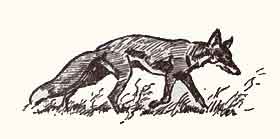 There are red and gray foxes, but the red fox is the most often seen in Virginia. The red fox also provides better sport, as he runs in large circles that challenge the hounds while staying in the country. The best way to learn about the fox’s habits is to talk to experienced foxhunters – everyone has a story.
There are red and gray foxes, but the red fox is the most often seen in Virginia. The red fox also provides better sport, as he runs in large circles that challenge the hounds while staying in the country. The best way to learn about the fox’s habits is to talk to experienced foxhunters – everyone has a story.
The foxhound is referred to as a hound, never a dog. Their use distinguishes foxhunters from all other equestrian sports. There are two groups of foxhounds in North America: those that are bred to hunt individually as in night hunting, and those that are bred to hunt in a pack. Of the pack hounds, there are different strains: Penn-Mary-Del, American, English, and the Crossbred. Each Hunt breeds for the traits which best suit their needs and their country.
Every year, the Farmington Hunt breeds two or three bitches, so we have puppies each year. Selective breading of foxhounds has been practiced for over 200 years.
Some desirable qualities in a hound are: nose, cry, drive, steadiness, biddability, and conformation. The training of young entry begins at three months; as time progresses, through handling, they learn obedience to the horn, and familiarity with horses and country. Ultimately, they learn from the older experienced hounds in the pack who are the best school masters in the Field. The hounds work very hard and have the complete right of way. Look for them to put their noses down and begin to work the line (scent). The more you observe their efforts, the more you can appreciate their talent and training, and the more enjoyable the art of foxhunting will become.
All members are welcome to “walk-out” from the kennels every morning (except Sunday).
The fellowship of foxhunting extends beyond the Hunt Field through various social and riding activities planned by the Hunt members and the Social Committee. Members are encouraged to participate.
Stirrup Cup: This is a mounted libation served at events such as the Opening Meet, Thanksgiving Day, Boxing Day, New Year’s Day or any special occasion when there are guests.
Hunt Breakfast: This is a gathering after the Hunt for refreshments and an opportunity to share the events of the day with your fellow foxhunters. Hunt jackets should be replaced by tweeds. Members are expected to participate in the giving of one or more Hunt Breakfasts by signing up with the Hunt Breakfast chairperson.
Hunter Pace, Hunter Trials, Horse Shows and Trail Rides: These are riding events that generally include food and fun.
Trail Clearing: This is a work party comprised of members who keep the hunt trails safe and free of hazards to horse and rider.
Meet and Mingles: These are monthly social gatherings at local restaurants, starting at 6:30pm. Members and guests are welcome. Members are encouraged to periodically sponsor the complimentary hors d'oeuvres served at a Meet and Mingle.
Hunt Ball: The Hunt Ball is a formal event at the end of the Hunt season for members and guests.
Contact the Social Chair or check out our Events for more information.
Members are encouraged to have guests in the Field; however, the member must have permission of a Master of Foxhounds, and the guest must be properly attired. On the day of the hunt, guests should arrive early to check in with the Field Secretary, sign waivers and pay any cap fees. Guests should be introduced to Masters and their Field Master (prior to announcements). Also, the guest must be accompanied by his/her sponsor and should remain in the rear of the Field unless personally invited by the Field Master to come forward. Those guests who wear the colors of another Hunt may sport their colors only with the permission of a Farmington Master of Foxhounds. Guests are welcome by invitation to special events.

The Fieldmaster may change the order at his or her discretion. Senior Members are designated by their longevity in the Hunt. “Green” horses should go in the back. Riders having difficulty with their horses should stay at the rear or go home.
Please click here for detailed information on membership categories and dues.

Click a logo to visit our sponsors.
Become a Sponsor